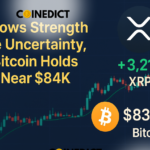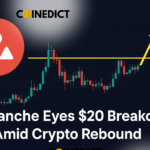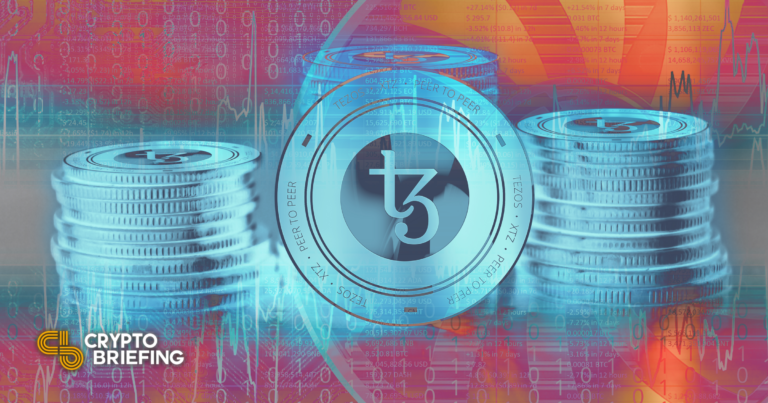
Infrastructure bill passes, Coinbase posts $1.6 billion in Q2 profit, $600 million stolen in DeFi hack: Hodler’s Digest, Aug.8-14
Coming every Saturday, Hodler’s Digest will help you track every single important news story that happened this week. The best (and worst) quotes, adoption and regulation highlights, leading coins, predictions and much more — a week on Cointelegraph in one link.Top Stories This Week Infrastructure bill passes US Senate — without clarification on cryptoOn Tuesday, the controversial infrastructure bill passed in the U.S. senate In a 69-30 vote.The bipartisan bill proposes roughly $1 trillion of funding into transportation and electricity infrastructure projects. The bill also puts forward more stringent rules for firms handling crypto assets while expanding reporting requirements for brokers, who will be required to report digital asset transactions worth more than $10,000 to the IRS. Six senators, including Pat Toomey, Cynthia Lummis, Rob Portman, Mark Warner, Kyrsten Sinema and Ron Wyden, proposed an amendment to the buzz-kill bill on Monday that would exempt software developers, transaction validators and node operators as brokers, while proposing that tax reporting requirements “only apply to the intermediaries.” Their efforts didn’t bear fruit, however, with further clarification on crypto not provided. Senator Toomey flamed the bill in the aftermath, noting that the legislation was “too expensive, too expansive, too unpaid for and too threatening to the innovative cryptocurrency economy.” Poloniex settles charges with SEC for operating unregistered exchangeThe United States Securities and Exchange Commission, or SEC, announced a $10 million settlement with cryptocurrency exchange Poloniex on Aug. 9. Poloniex was charged with facilitating trades in unregistered securities between July 2017 and November 2019. According to the indictment, the SEC also asserted that Poloniex employees were misbehaving, as they actively sought to circumvent securities regulation in a plot to increase the company’s market share. On the same day, SEC commissioner Hester Peirce — known colloquially as “Crypto Mom” due to her regular pushback against SEC crypto enforcement — slammed the regulators’ actions in a public statement. Crypto Mom questioned the regulators’ opaque regulatory framework that crypto firms must navigate in the U.S. while asserting that, even if Poloniex had tried to register with the SEC, they “likely would have waited…and waited…and waited some more” for a verdict. Coinbase’s Q2 profits top $1.6B as ETH volume surpasses BTC’s for the first timeCoinbase, the crypto exchange led by media-shy co-founder and CEO Brian Armstrong, posted Q2 profits of $1.6 billion this week. The firm released its Q2 report on Tuesday, and its net profit of $1.6 billion marked a mammoth increase of 4,900% compared to the $32 million recorded in the same period of 2020. Coinbase’s total revenue for the quarter was $2.23 billion, beating out analysts’ predictions of $1.78 billion in expected revenue. Interestingly, for the first time since Coinbase was founded nine years ago, Ethereum (ETH) had a higher trading volume than Bitcoin (BTC), with the assets representing 26% and 24% of total volume, respectively. 55% of the world’s top 100 banks reportedly have crypto and blockchain exposureDespite banks often taking time out of their busy schedules to slam crypto, a new research report found that 55 out of the top 100 banks by assets under management have some form of blockchain or crypto exposure. According to research by Blockdata, the banks and their subsidiaries have direct and indirect investments in crypto and decentralized ledger technology firms.Notable banking giants named and shamed included Barclays, Citigroup and Goldman Sachs, who were reported as the most active backers of crypto and blockchain firms, while JPMorgan Chase and BNP Paribas were also identified as serial investors in the sector. Winners and Losers At the end of the week, Bitcoin is at $46,262, Ether at $3,189 and XRP at $1.01. The total market cap is at $1.92 trillion, according to CoinMarketCap.Among the biggest 100 cryptocurrencies, the top three altcoin gainers of the week are IoTeX (IOTX) at 314.69%, XinFin Network (XDC) at 71.34%, and Ravencoin (RVN) at 71.23%. The top three altcoin losers of the week are THORChain (RUNE) at -12.02%, Quant (QNT) at -5.71%, and THETA (THETA) at -2.58%.For more info on crypto prices, make sure to read Cointelegraph’s market analysis. Most Memorable Quotations “If #Bitcoin were to catch up to #Ethereum’s performance this year, the No. 1 crypto’s price would approach $100,000.”Mike McGlone, senior commodity strategist for Bloomberg Intelligence “Shutting off this growth engine would be the equivalent of stopping e-commerce in 1995 because people were afraid of credit card fraud. Or regulating the creation of websites because some people initially thought they were complicated and didn’t understand what they would ever amount to.”Mark Cuban, billionaire investor “If you want to store your coins truly outside of the reach of the state, you can just hold those private keys directly. That’s the equivalent of burying a bar of gold in your backyard.”Nic Carter, co-founder of Coin Metrics “This legislation imposes a badly flawed, and in some cases unworkable, cryptocurrency tax reporting mandate that threatens future technological innovation.”Pat Toomey, U.S. Senator “I think we’re already past the stage of crypto early adoption.”Stephen Stonberg, Bittrex Global CEO “We are living in a time where everything is going digital, including traditional assets.”Austin Woodward, CEO of TaxBit “Given how slow we have been in determining how regulated entities can interact with crypto, market participants may understandably be surprised to see us come onto the scene now with our enforcement guns blazing and argue that Poloniex was not registered or operating under an exemption as it should have been.”Hester Peirce, commissioner of the U.S. Securities and Exchange Commission “Bitcoin’s journey to becoming Gold 2.0 has been beautiful.”Dan Held, Kraken director of growth marketingPrediction of the Week Bitcoin Technicals: Why BTC price breaking $48K resistance is the key to new all-time highsBitcoin has recovered a notable amount of ground in recent weeks. The asset hit its all-time high of almost $65,000 back in April but subsequently fell in the days and weeks after, finding its way down to around $30,000. On multiple occasions, the asset briefly fell below $30,000. Recent weeks, however, have shown bullish price movement for Bitcoin, as the asset has posted chart action seemingly indicative of a reversal, based on analysis from Cointelegraph’s Michaël van de Poppe. The $48,000 price range on Bitcoin’s chart sits as…










 (@DoveyWan) August 11, 2021 So why are Chinese projects flying so far under the radar? The first reason might be a cultural and language barrier as Chinese marketing teams struggle to integrate into the fast-moving and esoteric world of Crypto Twitter. Instead of trying to win over global communities, they focus on integrations that can bring users over directly.According to SimilarWeb, Poly Network attracted over 58% of its web traffic from third-party website referrals, with Chinese DApps OpenOcean, O3 Swap, and Wing Finance at the top of the list. By contrast, Compound Finance receives more than half of its visits from direct hits, with only 16% coming via third-party websites. Compound’s two main websites for referrals are CoinMarketCap and CoinGecko. This shows that the difference in how Chinese and international users behave is quite tangible and that to capture both audiences requires two very distinct strategies. A DeFi island: Chinese dApps and websites are the major onramps for users to Poly Network. Source: SimilarwebUntangling the web Another more taboo talking point is that many of these large Chinese DeFi projects have ties to other projects. Poly Network has ties to the O3 network, which itself is incubated by Neo. The extent to which Neo is involved is indistinct but it explains why it’s rare to see Poly Network founders marketing in public. These ‘founders’ are often just figureheads for the parent company. The parent company gets all the benefits of launching a second token without taking the reputational or legal risk of being tied to it. If the side project succeeds, it can support the main network. If it fails, everyone moves on with their lives and pretends it never happened. It’s a big PR problem for O3Swap now that many of their user’s assets were compromised in the attack. This isn’t the first time that the team has had to deal with negativity, as they were accused of having a backdoor function written into their code that would allow them to rug pull. Although this has never been exploited, it does raise eyebrows about the intentions of the developers. After the hack, a lot of negativity flooded local social media, with comments calling into question the integrity of Chinese-made projects. One user on Weibo stated that you could beat him to death before he touched a Chinese project while another user just called it an inside job. A user points out a potential backdoor in O3Swap’s code. Source: Weibo The bigger issue here is that prior to DeFi, substandard projects would never get off the ground, leading to a slow and painful soft decline in value for token holders. In this model, investors might still get the chance to recover some of their funds by selling on secondary markets. In the new model of DeFi forks, code can be deployed and amass hundreds of millions of dollars in TVL very rapidly and without adequate risk controls. Audits can be superficial, and staggeringly high yields can seduce retail investors into providing liquidity. If the code is compromised, all the assets are lost, resulting in a much more swift and comprehensive loss for investors. Looking for silver liningsThe major positive in all this was the quick and united response of the Chinese blockchain community. Smart contract auditor Slowmist worked quickly with exchanges to limit the options of the attacker to liquidate funds. The company blog notes:“Special thanks to the teams such as Hoo, Poly Network, Huobi ZLabs, ChainNews, WePiggy, TokenPocket, Bibox, OkLink and many individual partners for synchronizing relevant attacker information with the SlowMist security team on time under the premise of compliance, and buying valuable time for tracking attacker.” Huobi’s co-founder Du June choed this on social media as well, stating that they would do everything in their power to protect the crypto community. This will be a welcome sign to Chinese DeFi users who want to see trust being rebuilt among the local players. Huobi has taken notice of the large sum stolen from the #PolyNetwork tonight. Our risk control and security teams are already tracking and identifying the addresses involved. We’ll do everything in our power to assist and protect the crypto community. #StrongerTogether— Du Jun (@DujunX) August 10, 2021
(@DoveyWan) August 11, 2021 So why are Chinese projects flying so far under the radar? The first reason might be a cultural and language barrier as Chinese marketing teams struggle to integrate into the fast-moving and esoteric world of Crypto Twitter. Instead of trying to win over global communities, they focus on integrations that can bring users over directly.According to SimilarWeb, Poly Network attracted over 58% of its web traffic from third-party website referrals, with Chinese DApps OpenOcean, O3 Swap, and Wing Finance at the top of the list. By contrast, Compound Finance receives more than half of its visits from direct hits, with only 16% coming via third-party websites. Compound’s two main websites for referrals are CoinMarketCap and CoinGecko. This shows that the difference in how Chinese and international users behave is quite tangible and that to capture both audiences requires two very distinct strategies. A DeFi island: Chinese dApps and websites are the major onramps for users to Poly Network. Source: SimilarwebUntangling the web Another more taboo talking point is that many of these large Chinese DeFi projects have ties to other projects. Poly Network has ties to the O3 network, which itself is incubated by Neo. The extent to which Neo is involved is indistinct but it explains why it’s rare to see Poly Network founders marketing in public. These ‘founders’ are often just figureheads for the parent company. The parent company gets all the benefits of launching a second token without taking the reputational or legal risk of being tied to it. If the side project succeeds, it can support the main network. If it fails, everyone moves on with their lives and pretends it never happened. It’s a big PR problem for O3Swap now that many of their user’s assets were compromised in the attack. This isn’t the first time that the team has had to deal with negativity, as they were accused of having a backdoor function written into their code that would allow them to rug pull. Although this has never been exploited, it does raise eyebrows about the intentions of the developers. After the hack, a lot of negativity flooded local social media, with comments calling into question the integrity of Chinese-made projects. One user on Weibo stated that you could beat him to death before he touched a Chinese project while another user just called it an inside job. A user points out a potential backdoor in O3Swap’s code. Source: Weibo The bigger issue here is that prior to DeFi, substandard projects would never get off the ground, leading to a slow and painful soft decline in value for token holders. In this model, investors might still get the chance to recover some of their funds by selling on secondary markets. In the new model of DeFi forks, code can be deployed and amass hundreds of millions of dollars in TVL very rapidly and without adequate risk controls. Audits can be superficial, and staggeringly high yields can seduce retail investors into providing liquidity. If the code is compromised, all the assets are lost, resulting in a much more swift and comprehensive loss for investors. Looking for silver liningsThe major positive in all this was the quick and united response of the Chinese blockchain community. Smart contract auditor Slowmist worked quickly with exchanges to limit the options of the attacker to liquidate funds. The company blog notes:“Special thanks to the teams such as Hoo, Poly Network, Huobi ZLabs, ChainNews, WePiggy, TokenPocket, Bibox, OkLink and many individual partners for synchronizing relevant attacker information with the SlowMist security team on time under the premise of compliance, and buying valuable time for tracking attacker.” Huobi’s co-founder Du June choed this on social media as well, stating that they would do everything in their power to protect the crypto community. This will be a welcome sign to Chinese DeFi users who want to see trust being rebuilt among the local players. Huobi has taken notice of the large sum stolen from the #PolyNetwork tonight. Our risk control and security teams are already tracking and identifying the addresses involved. We’ll do everything in our power to assist and protect the crypto community. #StrongerTogether— Du Jun (@DujunX) August 10, 2021 




 Emmy* consensus, cutting block times by 50%
Emmy* consensus, cutting block times by 50%  Gas improvements, massively reducing gas consumption in smart contracts
Gas improvements, massively reducing gas consumption in smart contracts  Liquidity baking, leveraging governance mechanism and incentives to provide for public goods#Tezos #Granada pic.twitter.com/IL4zJBe9oU — Tezos (@tezos) August 6, 2021 Granada also introduces an experimental feature called liquidity banking. The new feature attempts to increase liquidity between the network’s native token (XTZ) and wrapped Bitcoin (tzBTC) by introducing a new incentive. Now, when users provide liquidity to the XTZ/txBTC pair, they can claim part of a small subsidy of 2.5 XTZ paid out every time the network mints a block. One of Tezos’ signature features is the ability to upgrade without forking the network into two separate blockchains. This self-amendment functionality simplifies the upgrade process, increasing stability for those developing on the network. Granada marks the third upgrade to Tezos this year. The network has experienced rapid growth, with smart contract activity increasing as more organizations choose to develop on Tezos. In April, France’s third-largest bank announced the launch of tokenized debt notes on the platform, making use of the improved smart contract functionality delivered in February’s Edo upgrade. In addition to finance, Tezos is also breaking into the NFT market. In May, Formula One team Red Bull Racing launched its first set of NFTs on the network. Since then, rival team McLaren has also partnered with Tezos to build an entire NFT platform involving McLaren Racing’s Formula One, INDYCAR, and esports ventures. Both teams stated that they chose Tezos over other potential partners due to the network’s low carbon footprint. Disclaimer: At the time of writing this feature, the author owned BTC and ETH. Share this article The information on or accessed through this website is obtained from independent sources we believe to be accurate and reliable, but Decentral Media, Inc. makes no representation or warranty as to the timeliness, completeness, or accuracy of any information on or accessed through this website. Decentral Media, Inc. is not an investment advisor. We do not give personalized investment advice or other financial advice. The information on this website is subject to change without notice. Some or all of the information on this website may become outdated, or it may be or become incomplete or inaccurate. We may, but are not obligated to, update any outdated, incomplete, or inaccurate information. You should never make an investment decision on an ICO, IEO, or other investment based on the information on this website, and you should never interpret or otherwise rely on any of the information on this website as investment advice. We strongly recommend that you consult a licensed investment advisor or other qualified financial professional if you are seeking investment advice on an ICO, IEO, or other investment. We do not accept compensation in any form for analyzing or reporting on any ICO, IEO, cryptocurrency, currency, tokenized sales, securities, or commodities. See full terms and conditions. Tezos Adds Support for Private Transactions and DeFi Contracts Tezos’s new upgrade supports private transactions while building a niche for DeFi applications. Tezos Promotes Privacy and Composable Contracts Nomadic Labs, Marigold, DaiLambda, and Metastate announced the new protocol upgrade… How to Trade Using the Inverse Head and Shoulders Pattern In stock or cryptocurrency trading, you may have heard of the term “inverse head and shoulders.” Also known as the “head and shoulders bottom” formation, the inverse head and shoulders chart pattern can… McLaren Racing Taps Tezos to Launch NFT Platform Another Formula One team joins the NFT rush. McLaren Racing Links With Tezos McLaren Racing is getting into NFTs. The popular Formula One team has partnered with Tezos in a… France’s 3rd Largest Bank Launches Tokenized Debt on Tezos Société Générale, the globe’s 17th largest bank, today announced the launch of a tokenized euro medium-term note (EMTN) on the Tezos blockchain. Société Générale Continues Crypto Experimentation “This new experimentation,…
Liquidity baking, leveraging governance mechanism and incentives to provide for public goods#Tezos #Granada pic.twitter.com/IL4zJBe9oU — Tezos (@tezos) August 6, 2021 Granada also introduces an experimental feature called liquidity banking. The new feature attempts to increase liquidity between the network’s native token (XTZ) and wrapped Bitcoin (tzBTC) by introducing a new incentive. Now, when users provide liquidity to the XTZ/txBTC pair, they can claim part of a small subsidy of 2.5 XTZ paid out every time the network mints a block. One of Tezos’ signature features is the ability to upgrade without forking the network into two separate blockchains. This self-amendment functionality simplifies the upgrade process, increasing stability for those developing on the network. Granada marks the third upgrade to Tezos this year. The network has experienced rapid growth, with smart contract activity increasing as more organizations choose to develop on Tezos. In April, France’s third-largest bank announced the launch of tokenized debt notes on the platform, making use of the improved smart contract functionality delivered in February’s Edo upgrade. In addition to finance, Tezos is also breaking into the NFT market. In May, Formula One team Red Bull Racing launched its first set of NFTs on the network. Since then, rival team McLaren has also partnered with Tezos to build an entire NFT platform involving McLaren Racing’s Formula One, INDYCAR, and esports ventures. Both teams stated that they chose Tezos over other potential partners due to the network’s low carbon footprint. Disclaimer: At the time of writing this feature, the author owned BTC and ETH. Share this article The information on or accessed through this website is obtained from independent sources we believe to be accurate and reliable, but Decentral Media, Inc. makes no representation or warranty as to the timeliness, completeness, or accuracy of any information on or accessed through this website. Decentral Media, Inc. is not an investment advisor. We do not give personalized investment advice or other financial advice. The information on this website is subject to change without notice. Some or all of the information on this website may become outdated, or it may be or become incomplete or inaccurate. We may, but are not obligated to, update any outdated, incomplete, or inaccurate information. You should never make an investment decision on an ICO, IEO, or other investment based on the information on this website, and you should never interpret or otherwise rely on any of the information on this website as investment advice. We strongly recommend that you consult a licensed investment advisor or other qualified financial professional if you are seeking investment advice on an ICO, IEO, or other investment. We do not accept compensation in any form for analyzing or reporting on any ICO, IEO, cryptocurrency, currency, tokenized sales, securities, or commodities. See full terms and conditions. Tezos Adds Support for Private Transactions and DeFi Contracts Tezos’s new upgrade supports private transactions while building a niche for DeFi applications. Tezos Promotes Privacy and Composable Contracts Nomadic Labs, Marigold, DaiLambda, and Metastate announced the new protocol upgrade… How to Trade Using the Inverse Head and Shoulders Pattern In stock or cryptocurrency trading, you may have heard of the term “inverse head and shoulders.” Also known as the “head and shoulders bottom” formation, the inverse head and shoulders chart pattern can… McLaren Racing Taps Tezos to Launch NFT Platform Another Formula One team joins the NFT rush. McLaren Racing Links With Tezos McLaren Racing is getting into NFTs. The popular Formula One team has partnered with Tezos in a… France’s 3rd Largest Bank Launches Tokenized Debt on Tezos Société Générale, the globe’s 17th largest bank, today announced the launch of a tokenized euro medium-term note (EMTN) on the Tezos blockchain. Société Générale Continues Crypto Experimentation “This new experimentation,…



 https://t.co/2iZ1kOiGhy
https://t.co/2iZ1kOiGhy  — startups.btc (@StacksStartups) June 23, 2021 The Eggschain solution has not yet been released. “I don’t want to commit to a timeline,” Escala says, in part because, “We are among the first developers building on the Stacks blockchain.” This seems to be a reasonable answer, as it is common for blockchain projects to hit delays — whether caused by technical, legal or budgetary challenges.While lower transaction fees influenced the choice to build on a Bitcoin sidechain instead of other chains like Ethereum, Bitcoin’s reputation as an incorruptible ledger was decisive. Bitcoin “will be around for hundreds or thousands or millions of years,” Escala says, as if stating a basic scientific fact. While speaking of millions of years can be written off as overzealous marketing, choosing a chain to track reproduction means backing the one most likely to survive far into the future.“Bitcoin is the oldest blockchain in the world and very established, and the gas fees are low compared to some of the other leading blockchains by a huge magnitude.”Escala explains that “When your sperm is donated, that is a transaction that gets hashed onto the blockchain,” complete with an indelible time stamp. Further transactions take place “when the sperm is implanted into a woman or into an egg.” The time between egg fertilization and implantation can stretch for years, and sperm has been kept frozen for as long as 22 years and still been used successfully.In practice, this means that a donor will be able to see how many times their sperm has been used, giving them a rough idea of how many children they might have and in what general areas. This may even serve to gamify the sperm donation experience, even if the donor is not willing to ever be contacted by their offspring. Though Bitcoin itself is a transparent blockchain that allows transactions to be traced back, Escala explains that Eggschain, as it functions with Stacks, cannot be “backtracked” in such a way that the “family tree” can be tracked up and down. This is by design, as “Just because someone received your donated sperm, it doesn’t give them the authority to read through your life — it is almost an invasion of your privacy,” according to Escala.“Patient identifiable information cannot be on the blockchain.”Freezing desireIn India and much of Africa, it is normal for women to have their first baby by the age of 20. At 25, the United States represents the lowest mean age in the Western world, with the average first-time mother in countries like Germany, Singapore, Japan, the United Kingdom and Australia flirting with or even surpassing 30 — the age at which fertility begins to decline.Though access to contraceptives and changed values contribute to the higher ages in the West, careers and finances often play a role. The pressure to delay pregnancy is all the more increased with the modern reality that career growth often requires frequent moving between offices and countries — though perhaps the work-from-home era will bring change. Heath issues like cancer, which is rising worldwide, is another driver for the treatment, as woman seek to preserve their eggs before they are potentially damaged through chemotherapy treatment. All things considered, it is easy to see why many women are choosing to freeze their eggs — just in case they decline in quality or run out before they want to use them. Eqq quality begins to reduce at 30 and drops fast from 35. Source: SheCares When her best friend chose to freeze her eggs in 2018, Escala “was a witness every step of the way — I felt like I almost lived through the entire experience.” In addition to a friend, however, she is a businesswoman, and she sensed an opportunity to improve the IVF process.In June 2018, Escala founded Eggschain.Breeding processProvided there is no preselected partner, the process of choosing sperm — or more accurately, a sperm donor — is an intimate and difficult one. For one, donors need to be checked at “an established lab for STDs, HIV and any hereditary diseases,” with their sperm held in quarantine for often up to six months.Depending on the sperm bank and the laws of the donor’s country, there is…
— startups.btc (@StacksStartups) June 23, 2021 The Eggschain solution has not yet been released. “I don’t want to commit to a timeline,” Escala says, in part because, “We are among the first developers building on the Stacks blockchain.” This seems to be a reasonable answer, as it is common for blockchain projects to hit delays — whether caused by technical, legal or budgetary challenges.While lower transaction fees influenced the choice to build on a Bitcoin sidechain instead of other chains like Ethereum, Bitcoin’s reputation as an incorruptible ledger was decisive. Bitcoin “will be around for hundreds or thousands or millions of years,” Escala says, as if stating a basic scientific fact. While speaking of millions of years can be written off as overzealous marketing, choosing a chain to track reproduction means backing the one most likely to survive far into the future.“Bitcoin is the oldest blockchain in the world and very established, and the gas fees are low compared to some of the other leading blockchains by a huge magnitude.”Escala explains that “When your sperm is donated, that is a transaction that gets hashed onto the blockchain,” complete with an indelible time stamp. Further transactions take place “when the sperm is implanted into a woman or into an egg.” The time between egg fertilization and implantation can stretch for years, and sperm has been kept frozen for as long as 22 years and still been used successfully.In practice, this means that a donor will be able to see how many times their sperm has been used, giving them a rough idea of how many children they might have and in what general areas. This may even serve to gamify the sperm donation experience, even if the donor is not willing to ever be contacted by their offspring. Though Bitcoin itself is a transparent blockchain that allows transactions to be traced back, Escala explains that Eggschain, as it functions with Stacks, cannot be “backtracked” in such a way that the “family tree” can be tracked up and down. This is by design, as “Just because someone received your donated sperm, it doesn’t give them the authority to read through your life — it is almost an invasion of your privacy,” according to Escala.“Patient identifiable information cannot be on the blockchain.”Freezing desireIn India and much of Africa, it is normal for women to have their first baby by the age of 20. At 25, the United States represents the lowest mean age in the Western world, with the average first-time mother in countries like Germany, Singapore, Japan, the United Kingdom and Australia flirting with or even surpassing 30 — the age at which fertility begins to decline.Though access to contraceptives and changed values contribute to the higher ages in the West, careers and finances often play a role. The pressure to delay pregnancy is all the more increased with the modern reality that career growth often requires frequent moving between offices and countries — though perhaps the work-from-home era will bring change. Heath issues like cancer, which is rising worldwide, is another driver for the treatment, as woman seek to preserve their eggs before they are potentially damaged through chemotherapy treatment. All things considered, it is easy to see why many women are choosing to freeze their eggs — just in case they decline in quality or run out before they want to use them. Eqq quality begins to reduce at 30 and drops fast from 35. Source: SheCares When her best friend chose to freeze her eggs in 2018, Escala “was a witness every step of the way — I felt like I almost lived through the entire experience.” In addition to a friend, however, she is a businesswoman, and she sensed an opportunity to improve the IVF process.In June 2018, Escala founded Eggschain.Breeding processProvided there is no preselected partner, the process of choosing sperm — or more accurately, a sperm donor — is an intimate and difficult one. For one, donors need to be checked at “an established lab for STDs, HIV and any hereditary diseases,” with their sperm held in quarantine for often up to six months.Depending on the sperm bank and the laws of the donor’s country, there is…